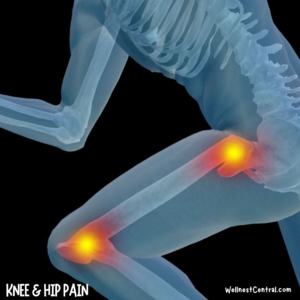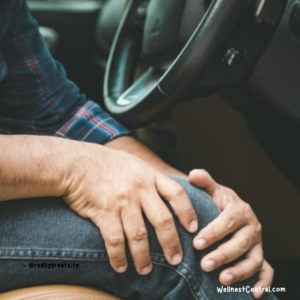Introduction
Are you tired of dealing with knee pain and calf pain that disrupts your daily life? Whether it’s a sudden, sharp pain leaving you hobbling or a constant, dull ache, knee and calf pain can hold you back from living life to the fullest. It affects not only athletes and active individuals but also those with sedentary lifestyles or seniors facing age-related discomfort. If you’ve ever wondered what might be causing this pain and how to find relief, you’re in the right place. In this article, we’ll explore the 7 most common causes of knee pain and calf pain and provide effective tips to help you find relief.
1. Muscle Strain or Overuse
One of the most common causes of knee pain and calf pain is muscle strain or overuse. Strains often happen when muscles and tendons are overexerted, leading to inflammation and soreness. This can be the result of high-impact exercises, a sudden increase in physical activity, or even long periods of standing or walking. For athletes, this pain may come from overtraining or insufficient warm-ups before exercising. For those who are less active, muscle strain can still occur when the muscles are not conditioned for sudden bursts of movement.
Relief Tips
- Rest and Ice: Rest the affected area and apply ice to reduce inflammation and pain.
- Gentle Stretching: Regularly stretching the muscles in your legs, such as calf stretches and hamstring stretches, can help alleviate tension.
- Massage and Foam Rolling: Using a foam roller can help release tight muscles and improve circulation.
Remember: Muscle strain usually improves with time, but if pain persists for more than a few weeks, consult a healthcare provider.
2. Arthritis (Osteoarthritis & Rheumatoid Arthritis)
Arthritis is a significant cause of knee pain and calf pain, especially in older adults. Osteoarthritis is characterized by the breakdown of cartilage in the knee joint, causing pain, stiffness, and inflammation. Rheumatoid arthritis, an autoimmune disorder, can also lead to swelling and pain in the knees and nearby areas, including the calf muscles.
Relief Tips
- Low-Impact Exercises: Swimming, cycling, and walking can strengthen muscles without stressing the joints.
- Anti-Inflammatory Diet: Incorporate foods rich in omega-3 fatty acids (like salmon), antioxidants (berries, nuts), and anti-inflammatory herbs (turmeric, ginger).
- Joint-Friendly Supports: Wearing knee braces or supportive footwear can alleviate pressure on the joints.
Note: If arthritis pain is affecting your quality of life, a consultation with a doctor for medications or physical therapy may be necessary.
3. Tendonitis and Tendinosis
Tendon-related issues, such as patellar tendonitis (often called “jumper’s knee”) and Achilles tendinosis, are frequently behind knee pain and calf pain. These conditions arise from the inflammation or degeneration of the tendons that connect the muscles to the bones. Patellar tendonitis usually affects those who engage in repetitive jumping or running activities, while Achilles tendinosis is characterized by pain in the back of the lower leg, above the heel.
Relief Tips
- Supportive Footwear: Wearing shoes with good arch support and cushioned soles can reduce strain on the tendons.
- Strengthening Exercises: Incorporate exercises that target the quadriceps, hamstrings, and calves to improve muscle balance.
- Gradual Progression: If you’re an athlete, gradually increase your activity level and incorporate rest days to allow your tendons to recover.
4. Poor Posture and Sedentary Lifestyle
A sedentary lifestyle and poor posture can be sneaky contributors to knee pain and calf pain. Long hours of sitting or standing, combined with improper body mechanics, can lead to muscle imbalances and weaken the supporting muscles around the knees and calves. This, in turn, places additional stress on the knee joints and calf muscles.
Relief Tips
- Posture Checks: Ensure proper alignment of your spine, knees, and hips when sitting or standing. Use ergonomic chairs and avoid slouching.
- Regular Movement Breaks: Take frequent breaks to stand, stretch, and walk around every 30 minutes if you have a desk job.
- Daily Stretches: Gentle stretches like hamstring stretches, calf stretches, and hip flexor stretches can improve muscle flexibility and balance.
5. Injuries and Trauma
Accidental injuries and trauma can often be the culprits behind sudden knee pain and calf pain. Injuries like ligament tears (ACL or MCL tears), fractures, or calf muscle strains often occur from falls, sports, or accidents. These can lead to immediate pain, swelling, and difficulty walking or bearing weight.
Relief Tips
- R.I.C.E. Protocol: Rest, Ice, Compression, and Elevation are key to managing acute injuries and reducing pain and swelling.
- Medical Evaluation: Seek immediate medical attention for severe injuries, difficulty walking, or excessive swelling to rule out fractures or ligament tears.
- Rehabilitation: Physical therapy and prescribed exercises can aid in proper recovery and restore normal function.
6. Nerve Issues – Sciatica and Nerve Entrapment
Pain radiating from the knee to the calf can sometimes be traced to nerve-related issues. Sciatica, which is caused by compression or irritation of the sciatic nerve, can lead to shooting pain from the lower back down through the knee and calf. Another nerve issue is the entrapment of the peroneal nerve, which may cause pain along the outer side of the calf.
Relief Tips
- Nerve Gliding Exercises: Gentle stretching and exercises that help mobilize the nerves can alleviate pressure on the sciatic or peroneal nerves.
- Mind Your Posture: Good posture while sitting or standing helps reduce pressure on the lower back and nerves.
- Seek Physical Therapy: Consulting a physical therapist can provide specialized exercises to relieve nerve pain and promote mobility.
7. Blood Clots – Deep Vein Thrombosis (DVT)
While less common, blood clots can cause knee pain and calf pain. Deep vein thrombosis (DVT) occurs when a clot forms in the deep veins of the leg, leading to symptoms like swelling, warmth, and pain in the calf and sometimes the knee. DVT is a serious condition that requires immediate medical attention as it can lead to complications like pulmonary embolism.
When to Seek Help
- Emergency Symptoms: Seek immediate medical attention if you experience swelling, redness, or warmth in the calf, along with severe pain.
- Risk Factors: DVT is more likely if you have prolonged inactivity (e.g., long flights or bed rest), clotting disorders, or a history of DVT.
Holistic Relief Strategies
Regardless of the cause, there are universal strategies to relieve knee pain and calf pain:
- Weight Management: Maintaining a healthy weight reduces stress on your knees and legs.
- Regular Exercise: Incorporate low-impact exercises like swimming, walking, and cycling to keep your muscles strong and your joints mobile.
- Proper Hydration and Diet: Staying hydrated and consuming a balanced diet with anti-inflammatory foods can support overall muscle and joint health.
Conclusion
Knee pain and calf pain can greatly impact your quality of life, but understanding their causes and implementing proper relief techniques can make a significant difference. From muscle strain to arthritis and nerve issues, each cause requires a unique approach for treatment and prevention. Remember, taking small steps like staying active, maintaining good posture, and seeking medical advice when necessary can help you find relief and regain control over your life.
Share Your Experience! Have you faced knee pain or calf pain? What strategies have worked for you? Share your tips or questions in the comments below!
FAQs
Q1. What is the most common cause of knee and calf pain?
The most common cause is muscle strain or overuse, often resulting from physical activity or prolonged periods of standing.
Q2. Can arthritis cause both knee and calf pain?
Yes, arthritis can lead to inflammation in the knee joint, which may also cause discomfort in the surrounding calf muscles.
Q3. How can I differentiate between muscle strain and a more serious injury like a ligament tear?
Muscle strain usually improves with rest and gentle stretching, while a ligament tear may cause persistent pain, swelling, and difficulty walking. Always seek medical advice if in doubt.
Q4. Are there any exercises that can help prevent knee and calf pain?
Yes, low-impact exercises such as swimming, cycling, and yoga can strengthen muscles, improve flexibility, and support joint health.
Q5. How serious is DVT and what should I do if I suspect it?
DVT is a serious condition requiring immediate medical attention. Symptoms include swelling, redness, warmth, and pain in the calf. Contact a healthcare professional immediately if these occur.
Related Article:
Hope for Sciatic Nerve and Hip Pain Sufferers: Proven Steps to Regain Comfort and Mobility



